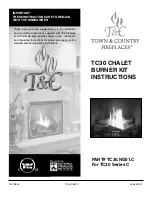
Regency P121-1/P121LC-1/P121RC-1/P131-1 Zero Clearance Direct Vent Gas Fireplace
21
Diagram 3
Diagram 5
Diagram 1
Diagram 2
Note: Apply sealant "Mill-Pac" to inner pipe
and high temperature silicone seal-
ant to outer pipe on every twist-lock
joint.
1)
Maintain the 1-1/4" clearances (air spaces)
to combustibles when passing through ceil-
ings, walls, roofs, enclosures, attic
rafter, or other nearby combustible
surfaces. Do not pack air spaces
with insulation. Check pages 17-19
for the maximum vertical rise of the
venting system and the maximum
horizontal offset limitations.
2)
Set the gas appliance in its desired
location. Drop a plumb bob down
from the ceiling to the position of
the appliance fl ue exit, and mark
the location where the vent
penetrate the roof. Determine if ceiling joists,
roof rafters or other framing will obstruct the
venting system. You may wish to relocate the
appliance or to offset, as shown in Diagram
2 to avoid cutting load bearing members.
3)
A Firestop spacer must be installed in the
fl oor or ceiling of every level. To install the
Firestop spacer in a fl at ceiling or wall, cut
a 10 inch square hole. Frame the hole as
shown in Diagram 3 and install the fi re-
stop.
4)
Assemble the desired lengths of pipe and
elbows. Ensure that all pipes and elbow
connections are in the fully twist-locked
position and sealed.
5)
Cut a hole in the roof centered on the small
drilled hole placed in the roof in Step 2. The
hole should be of suffi cient size to meet
the minimum requirements for clearance
to combustibles of 1-1/4". Slip the fl ashing
under the shingles (shingles should overlap
half the fl ashing) as per Diagram 4.
Diagram 4: The upper half of the fl ashing is
installed under the roofi ng material and not
nailed down until the chimney is installed. This
allows for small adjustments.
6)
Continue to assemble pipe lengths.
Note: If an offset is necessary in the attic
to avoid obstructions, it is important
to support the vent pipe every 3 feet,
to avoid excessive stress on the el-
bows, and possible separation. Wall
straps are available for this purpose
(Diagram 2).
Galvanized pipe is desirable above the roof-
line due to its higher corrosion resistance.
Continue to add pipe sections through the
fl ashing until the height of the vent cap meets
the minimum height requirements specifi ed
in Diagram 5 or local codes. Note that for
will penetrate the ceiling.
Drill a small hole at his
point. Next, drop a plumb
bob from the roof to the
hole previously drilled in
the ceiling, and mark the
spot where the vent will
Diagram 3
Diagram 4
Diagram 5
7)
Before connecting the horizontal run of vent
pipe to the vent termination, slide the Wall
Thimble (Part # 942) over the vent pipe.
8)
Slide the appliance and vent assembly
towards the wall carefully inserting the
vent pipe into the vent cap assembly. It is
important that the vent pipe extends into
the vent cap suffi cient distance so as to
result in a minimum pipe overlap of 1-1/4
inches. Secure the connection between the
vent pipe and the vent cap by attaching the
two sheet metal strips extending from the
vent cap assembly into the outer wall of the
vent pipe. Use the two sheet metal screws
provided to connect the strips to the pipe
section. See Diagram 4.
9)
Install wall thimble in the center of the 10"
square and attach with wood screws (Dia-
gram 5).
VERTICAL
TERMINATION
INSTALLATION
Roof Pitch Minimum Vent Height
Feet Meters
fl at to 7/12
2
0.61
over 7/12 to 8/12
2
0.61
over 8/12 to 9/12
2
0.61
over 9/12 to 10/12
2.5
0.76
over 10/12 to 11/12
3.25
0.99
over 11/12 to 12/12
4
1.22
over 12/12 to 14/12
5
1.52
over 14/12 to 16/12
6
1.83
over 16/12 to 18/12
7
2.13
over 18/12 to 20/12
7.5
2.29
over 20/12 to 21/12
8
2.44
















































